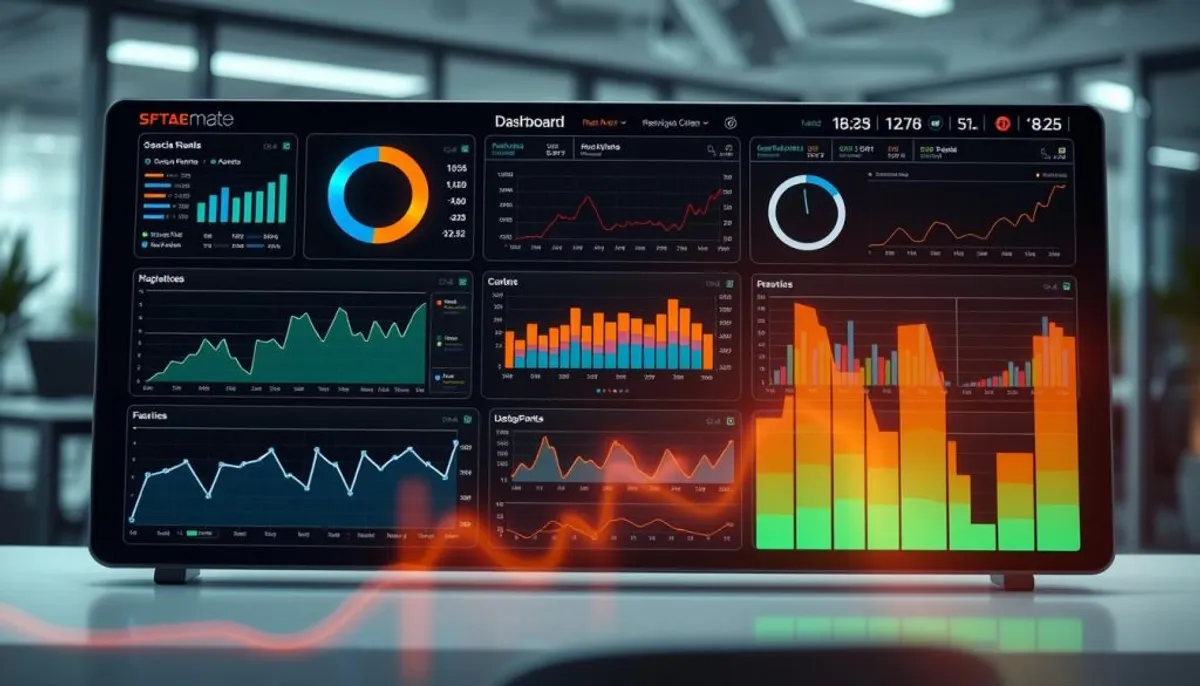In today’s fast-paced business world, efficient accounts receivable management is crucial. An automated collection system can revolutionize how companies handle payments and overdue accounts. By implementing debt collection software, businesses can streamline their processes, reduce manual tasks, and improve cash flow.

Modern automated collection systems, like ti3, offer a range of benefits. These SaaS platforms manage overdue accounts, send automated reminders, and collect payments efficiently. Unlike traditional debt collection agencies, these cost-effective solutions maintain positive client relationships while achieving better results.
The growing trend of automation in businesses is driven by advancements in AI and machine learning. By automating the accounts receivable function, companies can free up time for higher-value work. This shift not only accelerates cash flow but also enhances customer experiences through faster payments and streamlined communication.
Key Takeaways
- Automated collection systems streamline payment processes
- Debt collection software reduces manual tasks in accounts receivable
- Automation accelerates cash flow and improves accuracy
- SaaS platforms offer cost-effective solutions for managing overdue accounts
- Implementing automated systems enhances customer experiences
- Automation frees up time for higher-value work in businesses
Understanding Automated Collection Systems and Their Impact
Automated collection systems have transformed the management of outstanding debts for organizations. They enhance data collection, storage, and analysis efficiency. This transformation makes the collection process more streamlined and effective.
Defining Modern Collection Automation
Modern collection automation leverages technology for debt recovery management. The IRS’s Automated Collection System (ACS) exemplifies this, handling delinquent taxes and returns with various enforcement tools. It captures vital information such as Social Security Numbers, names, addresses, and tax account details.
The Evolution of Payment Processing
Payment processing has transitioned from manual to advanced digital systems. Contemporary collection agency software integrates with CRM tools and payment gateways. This integration facilitates real-time data capture and intelligent processing, minimizing errors and enhancing decision-making.
Key Components of Collection Systems
Effective automated billing systems comprise several essential components:
- Data collection and verification tools
- Workflow automation
- Communication management
- Reporting and analytics
These components synergize to facilitate a seamless collection process. For example, the IRS ACS interfaces with various databases for accurate and current information. It also employs statistical verification to ensure data integrity.
| Feature | Benefit |
|---|---|
| Automated billing | Reduces manual errors |
| Integrated payment processing | Speeds up collections |
| Data analytics | Improves decision-making |
Benefits of Implementing an Automated Collection System
Adopting an automated collection system can transform your revenue cycle management. These systems bring numerous advantages, enhancing operational efficiency and productivity. Let’s examine the primary benefits that position automated collection systems as a pivotal innovation for enterprises.
Automation significantly boosts efficiency. Financial services entities witness a 70% efficiency gain post-implementation. This improvement manifests as expedited transaction processing and enhanced cash flow. Automated systems can expedite payment processing by 60%, facilitating quicker transactions and superior liquidity.
Automated systems also dramatically reduce errors. They minimize human error in data entry by 90%. Such precision is vital for maintaining accurate records and averting costly mistakes in dunning management. It also aids in regulatory compliance, potentially reducing compliance costs by 40% through streamlined processes and detailed transaction logs.
- 50% reduction in operational costs
- 25% increase in customer retention rates
- 30% improvement in informed decision-making
Customer satisfaction surges with automated systems. An astonishing 87% of customers favor companies offering flexible payment options through automation. This preference enhances customer experiences and loyalty. Businesses utilizing these systems report a 25% increase in customer retention, highlighting the significance of convenience in fostering enduring client relationships.
Automated collection systems are not merely about efficiency; they are about intelligent growth. They facilitate a 30% increase in informed decision-making through enhanced reporting and analytics. This data-driven approach empowers businesses to make more strategic decisions and optimize their revenue cycle management.
Essential Features of Collection Software Solutions
Collection software solutions are revolutionizing delinquent account recovery and streamlining collections and recovery processes. These tools introduce key features that significantly enhance efficiency and effectiveness in managing overdue accounts.
Payment Processing Capabilities
Modern collection software boasts robust payment processing features. These systems can dramatically reduce invoice costs by eliminating the need for manual sending practices. They also expedite the payment process, leading to enhanced cash flow. By automating transactions, businesses can significantly shorten the collections timeline from weeks to mere days.
Customer Communication Tools
Effective communication is paramount in collections and recovery. Collection software automates outreach through various channels, including email, SMS, and pre-recorded calls. This approach saves considerable time and enables personalized interactions, thus fostering better customer relations. The software serves as a central hub for account management, allowing teams to monitor progress and prioritize collection efforts.
Reporting and Analytics Functions
Data-driven decision making is essential in collections. Collection software provides powerful reporting and analytics tools that track critical metrics such as collection rates and average time to collect. These insights empower businesses to refine their strategies, identify payment patterns, and enhance overall collection performance. With automated data entry, the software ensures the accuracy and reliability of decision-making processes.
| Feature | Benefit |
|---|---|
| Automated Payment Processing | Reduces invoice costs, improves cash flow |
| Multi-channel Communication | Saves time, enhances customer relations |
| Analytics and Reporting | Optimizes strategies, improves collection performance |
Streamlining Accounts Receivable Management
Accounts receivable management is vital for a company’s financial stability. An automated collection system transforms this process, turning it from a labor-intensive task into a seamless operation. By integrating diverse data sources and automating workflows, enterprises can notably decrease their average accounts receivable period. This, in turn, enhances cash flow.

Small and midsize businesses can gain significant advantages from automating accounts receivable tasks. These include managing invoices, sending due date reminders, and processing recurring payments. The results are striking – the average small business in the US is owed $84,000 in unpaid invoices. Automation can recover this lost revenue.
An effective automated collection system offers:
- Real-time visibility across accounts receivable processes
- Automated invoice generation and delivery
- Customizable reminder schedules for different customer segments
- Automated late fee calculation and application
- Integration with accounting software
By utilizing these features, businesses can pinpoint areas affecting their financial health and act proactively. For example, sending a friendly reminder 3-5 days before the due date can notably reduce late payments. If payment isn’t received by the due date, another automated reminder can be sent.
Introducing an automated collection system not only streamlines internal tasks but also bolsters payment collection strategies. This approach fosters better financial relationship management while reducing Days Sales Outstanding (DSO). Ultimately, it leads to better cash flow and a stronger financial standing.
Integration Capabilities with Existing Systems
Modern enterprises demand seamless connections between their various tools. Automated billing and payment processing systems must integrate with existing software to enhance efficiency. We will examine key integration options for collection systems.
CRM Integration Options
Integrating your collection system with Customer Relationship Management (CRM) software offers a unified view of customer interactions. This integration facilitates better tracking of payment histories and communication preferences. Sales teams can access current account statuses, enhancing customer service and reducing errors.
Payment Gateway Connections
Secure payment processing necessitates robust gateway integrations. By connecting your collection system to popular payment gateways, you enable smooth transactions and diminish manual data entry. This integration streamlines the flow of financial information, accelerating the payment cycle.
Database Compatibility
Ensuring your automated billing system’s compatibility with existing databases is essential. Compatibility allows for effortless data migration and synchronization. It preserves historical records while leveraging new collection features.
| Integration Type | Benefits | Implementation Complexity |
|---|---|---|
| CRM Integration | Unified customer view, improved service | Medium |
| Payment Gateway | Secure transactions, faster processing | Low to Medium |
| Database Compatibility | Data consistency, historical record preservation | High |
By focusing on these integration capabilities, businesses can create a cohesive system that enhances automated billing and payment processing workflows. This results in a more efficient, error-free operation that scales with your company’s growth.
Automated Billing and Payment Processing Workflow
Automated billing and payment processing enhance financial operations, significantly boosting efficiency and cash flow. Debt collection software integrates these functions, creating a seamless workflow. This saves time and reduces errors, making financial management more efficient.
Karbon Practice Management showcases the power of automation in billing. Users experience substantial time savings and faster payments from clients. The system allows for custom rates based on roles or tasks, adding flexibility to billing practices.
Automated systems provide real-time tracking of work in progress, realization rates, and aged receivables. This visibility aids in identifying potential cash flow issues early. With collaborative invoicing features, teams can customize and review invoices before approval.
| Benefit | Impact |
|---|---|
| Time Savings | Hours off billing process |
| Payment Speed | Increased prompt payments |
| Accounts Receivable | Reduced outstanding balances |
| Payment Options | Secure credit card and ACH |
The adoption of automated billing systems spans various industries. Subscription-based services, telecommunications, utilities, and healthcare sectors leverage these systems to manage complex billing scenarios efficiently. E-commerce platforms benefit from automated handling of diverse pricing structures and international transactions.
Implementing payment processing automation can reduce invoicing costs by up to 70%. This efficiency gain, coupled with the elimination of manual data entry, significantly reduces errors and improves overall financial management.
Enhanced Revenue Cycle Management Through Automation
Revenue cycle management automation significantly enhances healthcare providers’ operations. An automated collection system streamlines processes, leading to faster payments and reduced errors. This technology optimizes payment timelines, cuts processing delays, and boosts cash flow.
Payment Timeline Optimization
Automated systems expedite payment collection, reducing the accounts receivable period. Real-time tracking of outstanding balances enables immediate follow-ups, ensuring prompt payments. This proactive approach minimizes revenue leakage and enhances financial stability for healthcare providers.
Reducing Processing Delays
Revenue cycle management automation directly addresses processing delays. It streamlines tasks such as eligibility verification, prior authorizations, and claims processing. This efficiency results in fewer errors and faster reimbursements.
Cash Flow Improvement Strategies
Automated collection systems offer robust strategies to enhance cash flow. They automatically post payments, match them to claims, and maintain accurate financial records. This precision leads to quicker payment cycles and improved financial performance.
| Metric | Impact of Automation |
|---|---|
| Cost-to-Collect Reduction | 27% |
| Net Patient Revenue Increase | 6% |
| Claim Denial Reduction | Up to 30% |
| Rejection Rate Reduction | Up to 40% |
By integrating revenue cycle management automation, healthcare providers can recover a substantial portion of lost revenue from denied claims. This technology not only improves financial outcomes but also enhances team collaboration and decision-making processes.
Improving Customer Experience with Digital Collections

Digital collections are transforming the payment process for businesses and their customers. Automated systems enable personalized and convenient interactions. This not only boosts customer satisfaction but also encourages timely payments.
McKinsey’s research highlights the benefits of digital omnichannel collections. It shows a 20-25% drop in non-performing loans and a 25% rise in resolving overdue accounts. This method also cuts collection costs by 15%.
Digital channels excel in dunning management. SMS messages, for instance, are opened 90% of the time within three minutes. Offering self-service and various payment options meets customer needs and simplifies the process.
The advantages of digital collections go beyond financial gains. Engagement jumps fivefold with digital strategies. Companies with high empathy earn 50% more than those with low empathy.
To enhance digital collection effectiveness:
- Capture contact data during the origination phase
- Segment portfolios for personalized messaging
- Listen to customers and measure strategies
- Maintain agility in your approach
Embracing digital collections and automated systems benefits both sides. Customers get a more flexible and respectful experience. Businesses see improved cash flow and stronger customer ties.
Security and Compliance in Automated Collections
In the realm of automated collections, security and adherence to regulations are paramount. Collection agency software must adhere to stringent standards to safeguard sensitive data and comply with regulatory frameworks. This section delves into the critical elements of ensuring your automated collection system’s security and regulatory compliance.
Data Protection Measures
Ensuring the protection of customer information is of utmost importance. Automated collection systems employ robust encryption to secure data during both storage and transmission phases. Regular security audits are indispensable, as they enable the identification and rectification of vulnerabilities. These precautions are imperative, given that the average cost of a data breach skyrocketed to $4.45 million in 2023.
Regulatory Compliance Standards
Collection agencies are subject to a myriad of regulatory requirements. The Fair Debt Collection Practices Act (FDCPA) delineates the parameters for debt collection activities. Data privacy laws such as GDPR and CCPA further complicate the regulatory landscape. Automated systems facilitate compliance by establishing standardized workflows that ensure adherence at every juncture.
Privacy Considerations
Consumer privacy must be respected at all times. Automated collection systems must obtain explicit consent for data collection and utilization. They must also furnish transparent information regarding data usage. In 2022, over 8,500 complaints were lodged concerning medical debt collection practices, underscoring the necessity for privacy-centric methodologies.
By integrating stringent security protocols and strict adherence to regulatory standards, collection agencies can foster trust among consumers while optimizing their operations through automation.
Measuring Success and ROI in Collection Automation
Evaluating the effectiveness of an automated collection system is crucial for businesses. By tracking key performance indicators, companies can gauge the success of their collections and recovery efforts. Let’s explore some metrics that highlight the impact of automation on collection processes.
Implementing an automated collection system can lead to significant improvements in efficiency and cost savings. For instance, companies using manual collection methods often spend 30% of their time on preparation and only 20% on customer communication. In contrast, automation allows for more focused customer interaction and streamlined processes.
The return on investment (ROI) for automated collection systems can be substantial. One company reported a one-year saving of $589,522 and working capital savings of $21,747,945 after implementing an automated solution. This demonstrates the potential for significant financial benefits through automation.
Key metrics to consider when measuring the success of an automated collection system include:
- Reduction in Days Sales Outstanding (DSO)
- Increase in collection rate
- Decrease in manual labor costs
- Improvement in cash flow
- Reduction in bad debt write-offs
Real-world examples showcase the tangible benefits of automation. One company saw a 10-day reduction in DSO and doubled its collections team efficiency. Another reported a 75% reduction in bad debt write-offs and a 50% decrease in 90-day aged accounts.
| Metric | Manual Process | Automated System |
|---|---|---|
| Time spent on preparation | 30% | 10% |
| Time spent on customer communication | 20% | 40% |
| Bad debt write-offs | 100% | 25% |
| 90-day aged accounts | 100% | 50% |
By leveraging real-time reporting and analytics provided by automated systems, businesses can continuously monitor these metrics. This data-driven approach enables companies to make informed decisions and optimize their collection strategies for maximum efficiency and effectiveness.
Best Practices for Implementation and Adoption
Implementing an automated collection system or debt collection software necessitates meticulous planning and execution. Success is contingent upon effective staff training, change management, and performance monitoring.
Staff Training Requirements
Comprehensive training is paramount for a seamless adoption. Employees must grasp new system functionalities and workflows. Develop customized programs for various user groups, emphasizing their specific roles in the collection process.
Change Management Strategies
Overcoming resistance requires clear communication of benefits. Gartner research underscores the importance of highlighting business advantages in software adoption. Initiate with a pilot test in one department to showcase positive outcomes. Gradually deploy the automated collection system across the organization.
Performance Monitoring Tips
Regular monitoring is essential for optimal utilization of your debt collection software. Track critical metrics such as collection rates, processing times, and customer satisfaction. Utilize data from Enterprise Telephone Data reports and Agent Activity Reports to gauge efficiency. Adjust strategies based on these insights for continuous enhancement.
- Set clear expectations for software value
- Provide ongoing support and training
- Encourage feedback from users
- Regularly review and update processes
Implementation is a continuous process, not a singular event. With diligent planning and execution, your automated collection system can profoundly enhance your organization’s efficiency and profitability.
Conclusion
Automated collection systems have transformed the landscape of accounts receivable management, providing businesses with a robust tool for streamlining financial operations. The IRS Automated Collection System (ACS) exemplifies this impact, having collected a remarkable $5.4 billion in fiscal year 2013 from open Taxpayer Delinquent Accounts. This achievement highlights the system’s capability to significantly enhance financial recovery.
The efficiency of these systems is undeniable. In 2018, ACS managed an inventory of $47 billion, directly collecting $3.4 billion and an additional $4.3 billion through installment agreements. This demonstrates the system’s prowess in handling vast transaction volumes and recovering substantial sums. For enterprises, this equates to enhanced cash flow and diminished administrative overhead.
Despite their effectiveness, there is a need for improvement. The data indicates that personal communication remains paramount. Letters and phone calls were found to be more effective than automated levies in eliciting taxpayer responses. This emphasizes the necessity of incorporating human interaction within automated systems. Achieving a harmonious blend of automation and personal touch can significantly improve accounts receivable management, leading to increased efficiency and customer satisfaction.
RelatedRelated articles



